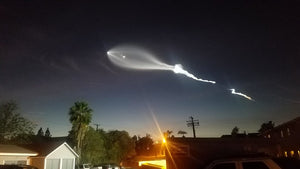Worldwide Space Schedule
Via Space.comSept. 3: Mercury reaches its highest point in the evening sky. Shining at magnitude 0.1, the innermost planet will be barely visible above the western horizon at sunset.
Sept. 3: Russian cosmonauts Oleg Novitsky and Pyotr Dubrov will take a spacewalk outside the International Space Station to begin outfitting the Nauka Multipurpose Laboratory Module. The spacewalk is scheduled to begin at 10:35 a.m. EDT (1435 GMT) and will last about 6 hours, 50 minutes.
Sept. 6: The new moon arrives at 8:52 p.m. EDT (0052 Sept. 7 GMT).
Sept. 9: Russian cosmonauts Oleg Novitsky and Pyotr Dubrov will take another spacewalk outside the International Space Station to continue outfitting the Nauka Multipurpose Laboratory Module. The spacewalk is scheduled to begin at 11 a.m. EDT (1400 GMT) and will last about 5 hours.
Sept. 9: Conjunction of the moon and Venus. The waxing crescent moon will pass about 4 degrees to the north of Venus. Look for the pair above the western horizon after sunset.
Sept. 13: Mercury at greatest elongation east. The innermost planet will reach its greatest eastern separation from the sun, shining brightly at magnitude 0.1. Catch the elusive planet above the western horizon shortly after sunset.
Sept. 14: Neptune at opposition. The gas giant will appear at its biggest and brightest of the year, shining at magnitude 7.8. (You'll need a telescope to see it.)
Sept. 14: Arianespace will use a Soyuz rocket to launch 34 satellites into orbit for the OneWeb internet constellation. The mission, called OneWeb 10, will lift off from the Baikonur Cosmodrome in Kazakhstan.
Sept. 15: SpaceX will use a Falcon 9 rocket and Crew Dragon spacecraft to launch the first all-civilian orbital mission, known as Inspiration4. It will lift off from Launch Complex 39A at NASA's Kennedy Space Center in Florida.
Sept. 16: Conjunction of the moon and Saturn. The waxing gibbous moon will swing about 3 degrees to the south of Saturn in the evening sky.
Sept. 18: Conjunction of the moon and Jupiter. The waxing gibbous moon will swing about 4 degrees to the south of Jupiter in the evening sky.
Sept. 20: The full moon of September, known as the Full Harvest Moon, occurs at 7:55 p.m. EDT (2355 GMT).
Sept. 22: The equinox arrives at 3:21 p.m. EDT (1921 GMT), marking the first day of autumn in the Northern Hemisphere and the first day of spring in the Southern Hemisphere.
Sept. 23: A United Launch Alliance Atlas V rocket will launch the NASA/USGS Landsat 9 satellite from Vandenberg Space Force Base in California, at 2:11 p.m. EDT (1811 GMT).
Sept. 24: The waning gibbous moon and Uranus will make a close approach, passing within 1.3 degrees of each other. Shining at magnitude 5.7, Uranus may be bright enough to spot with the naked eye under dark skies.
Sept. 30: The Japan Aerospace Exploration Agency (JAXA) will use an Epsilon rocket to launch the Rapid Innovative Payload Demonstration Satellite 2 (RAISE 2), a technology demonstration mission, from the Uchinoura Space Center at 8:48 p.m. EDT (0048 Oct. 1 GMT).
Also scheduled to launch in September (from Spaceflight Now):
- Rocket Lab will use an Electron rocket to launch two Earth observation satellites for the Seattle-based company BlackSky Global's planned constellation. The mission, nicknamed "Love At First Insight," will lift off from the Mahia Peninsula in New Zealand. This will be the first in a rapid succession of three BlackSky launches by Rocket Lab scheduled to launch in September.
- A SpaceX Falcon 9 rocket will launch another batch of Starlink internet satellites from Vandenberg Space Force Base in California.
- China will launch the Tianzhou 3 cargo resupply ship to the Chinese space station. It will lift off on a Long March 7 rocket from the Wenchang Spacecraft Launch Site in Hainan, China.
- Arianespace will use an Ariane 5 ECA rocket to launch the SES 17 and Syracuse 4A communications satellites from the Guiana Space Center near Kourou, French Guiana.







